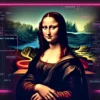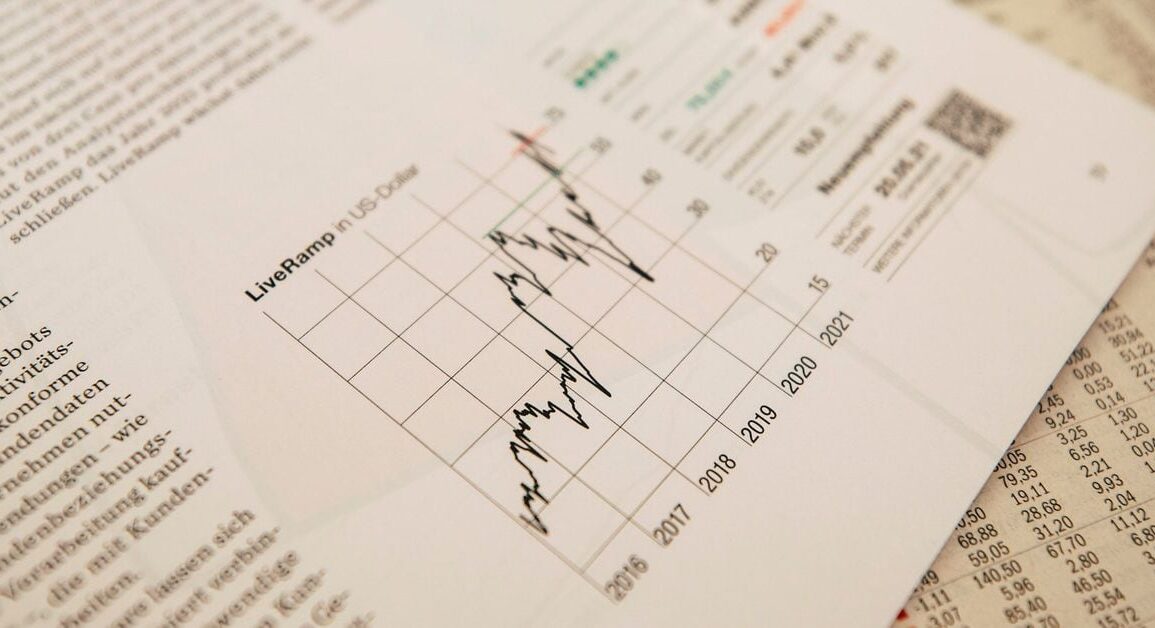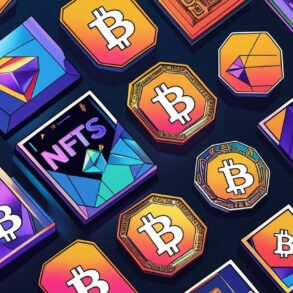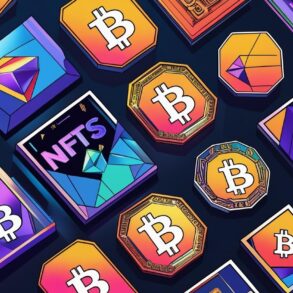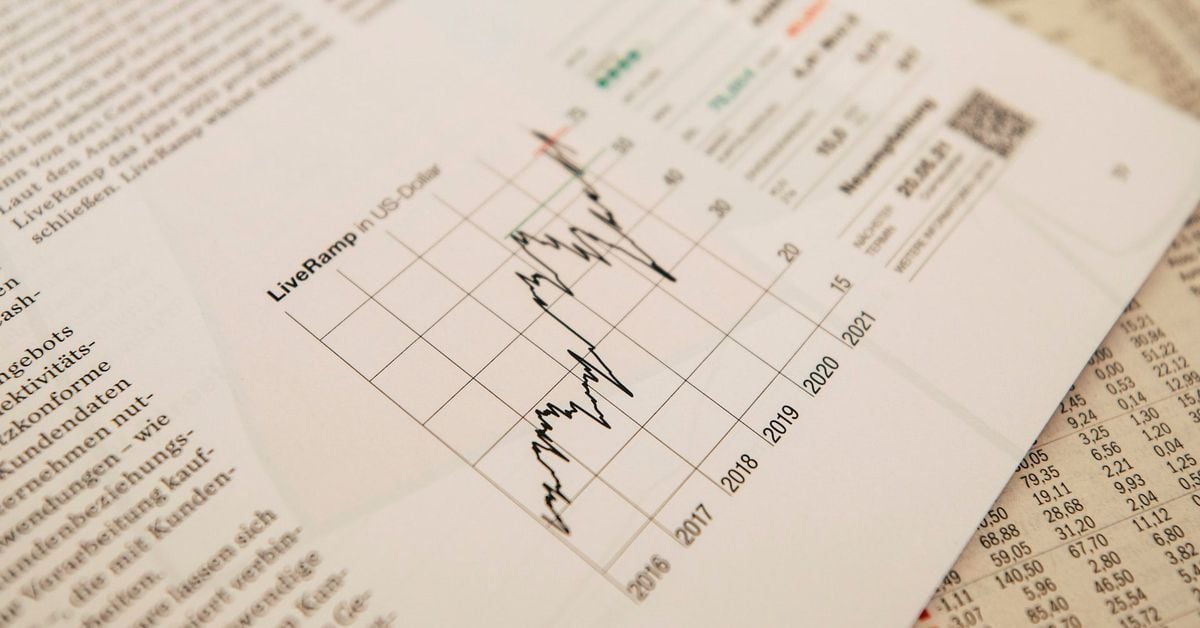
What does the future look like for NFTS and Art? The future is bright. I think there’s a lot of exciting things coming and I think this technology married to a generative is just really special. That was Art Blocks founder and Ceo Eric Calderon on what the future of art could look like with Blockchain technology. Stick around for that interview in just a few minutes. Good afternoon and welcome to first mover on coin desk on this show. You get all of your top news headlines and interviews with industry heavy hitters. So let’s get right into it and take a look at what’s happening in the news this morning, Bitcoin rallied to a four week high on Thursday nearing $45,000. L Max Digital commented that the move from a technical standpoint means that Bitcoin has broken out of a range that could be looking for a push to a fresh yearly high through $50,000. Meanwhile, the coin desk 20 index which tracks the world’s largest and most liquid cryptocurrencies is also trading nearly 4% higher. A new research report from JP Morgan claims there’s evidence that Blackrock and fidelity spot Bitcoin ETF S already have an advantage over gray scale when it comes to certain liquidity metrics linked to market breadth. Analysts say even though outflows from gray scales, G BT C slowed in the fourth week following approval by the SEC, the fund is expected to lose out to the newly created ETF S if it doesn’t make a meaningful cut to its fees and do Kwon has won another chance to change his extradition from Montenegro. The appeal he received is likely a minor victory for the Terraform Labs co-founder who initially won an appeal in November only for it to be overturned. Later, Kwan’s former CFO at Terraform was also extradited to South Korea by Montenegrin authorities on Monday, generative art platform. Art Blocks recently acquired Sansa, a well known marketplace in digital and generative art. Here to weigh in on the future of digital art is Art Blocks founder and Ceo Eric Calderon, Eric. Welcome to the show. Thank you so much for having me. Of course, congratulations on the acquisition. We’re going to talk about that in just a bit, but for the uninitiated, give us a brief history of art blogs. I know you founded the company in 2021. Tell us about your journey. Yeah, I mean, uh I’ve always been someone that was tinkering with computer code as a form of art and a huge nerd for Blockchain technology. Uh been in the space since 2017, claimed some crypto punks and just kind of had an unlocked moment that, uh, Blockchain technology married with generative art was kind of a perfect marriage of, of art and technology. And, uh, yeah, so it was my hobby entirely and, uh, I kind of launched it as just another participant in web three, launching something fun. And it turned into something much bigger than, than a hobby very quickly. And since then we’ve worked with almost 300 artists or released over 500 projects. And yeah, just leaning into this medium is something that I’m just really passionate about. Generative art started to become popular years ago. I believe it was back in the sixties, I only started really learning about it last year. What do you think it is about Blockchain technology and NFTS that’s making this kind of art uh more popular to a mainstream audience now. Uh I mean, there’s a lot to unpack there. I think first from just like a purely technical perspective, uh the Blockchain is not a great way to store data. And so if you want to upload an image, for example, a photograph for the Blockchain, it’s quite complex and quite expensive. Um with generative art, it’s art created with computer code. And so using a few lines of computer code, you can generate an image that is one megabyte or 100 megabytes depending on the size uh of the of the screen that you’re rendering in. And it’s all made with the same few lines of code. So with just a few lines of code, you can create uh artistic pieces and uh using the, the entropy or the randomness of the Ethereum Blockchain. Uh an artist can program that code to generate a different output for every single NFT. Um And that’s usually generated the moment that it’s minted. So I think there’s, you know, there’s a surprise factor of, you don’t know what you’re going to get when you mint something. There’s a immutability factor where you’re not, you’re not counting on external storage to store the the actual artwork, you’re actually just counting on everything coming from the Blockchain itself. And I think, you know, initially, I think it just was like a fascinating concept that you could have high resolution art created using Blockchain technology. But it, it also um I think triggers this concept or this narrative of one of one of X and that you can be an individual within a larger family of art or a larger family of a, of a, of a project with something unique to you. And as cryptopsy, people like to represent themselves in the digital space as an individual, as a unique individual. What do you think the future of art nfts look like? I mean, if we look at how NFTS have performed over the past year, it has not compared to the last bull market, we have even seen some NFT platforms kind of looking at different ways to do business. Some are not even focusing on art or PFP projects anymore. Uh When you think about the future of NFTS, where do, where does generative art kind of fit into the narrative? Well, I mean, this was born when things were really slow. I mean, this was born, this concept was born in 2017. It was launched in uh late 2020 kind of really took off in 2021. Um But this was born out of a market that was not anywhere near what we saw in 2021. And I remain uh with the same conviction of what we’re doing today as the conviction that I had back then with some extra validation. And, and what happened in 2021? I’d say that what happened in 2021 though, uh for not just generative art for digital art, uh kind of almost set it back a little bit and that it kind of turned into this frenzy and it set some expectations. At the same time, it elevated some incredible art by incredible artists to be able to be in dialogue, not just with the broader web three community, but also with the traditional art world. And uh it might have been necessary for some of those headlines to exist in order to get, get the attention outside of our nerdy little corner of the universe. I think we’re gonna have cycles and I think we’re gonna have to feel out the technology and, and feel out the collector ship. But you know, if we as a generative art platform, uh which was a highly, highly uh niched space, we’re able to capture the imagination of the people that joined early on. Uh I think that long term this medium, especially using Blockchain technology will continue to evolve. And I think, you know, from, from my perspective, when I launched our blocks, I launched it as a platform for generative content in general. So it wasn’t just purely about the art, the art exploded. And I mean, it’s maybe my proudest achievement to, to see the collection of art that’s existed there. So we’re just scratching the surface of what it means to create things uh for people on the fly that are unique to them, but part of a broader family. And I do see a great potential for a larger broader consumer audience being interested in this. So right now, we’re working with a very small group of people in a very niche industry and just like most technology, we need to get through some hurdles for on boarding um and just understanding the technology, but I do see a future where this is more mainstream, significantly more mainstream and that future really just kind of keeps us uh pushing forward through the ups and the downs of the ecosystem. Today, we recently asked our social media audience if they had any questions about NFTS and the predominant theme that came out in the questions that we received uh was related to royalties. Talk to me about how uh NFTS are shifting the way royalties are distributed and maybe tie that into how you’re thinking about royalties over at art blocks. Yeah, I mean, this is a really complex conversation. There’s a lot of layers here and part of it is just an acknowledgment on my part and on the part of a lot of artists that there’s a lot of different participants in this ecosystem with different goals. And I think one of the things you know, so initially royalties were they were never baked in, they were never guaranteed by smart contract, but there was a social contract where marketplaces upheld the royalties and that dramatically shifted last year, which had a significant impact in the in the royalties that artists and platforms collect. Um that said there’s room for everybody here. And I think that, you know, a lot of the narrative for a while was to punish the people that don’t pay the royalties. And I think that’s, I think that’s misguided. I think everybody this is a, this is a permissionless technology. You are entitled to operate on this technology in whichever way you want to operate. At the same time as you see the career of an artist or you see the trajectory of a platform going in a certain direction if you want to support that if you want to participate, that if you want to demonstrate that you’re supportive of that uh beyond just, you know, flipping an NFT or even, you know, being a little bit more on the speculative side, there’s an opportunity for you to do that and to signal that you’re more of a patron. And what we’re finding is just like with the traditional art world, it’s very easy for a patron uh or for, for an art collector to, to take a misstep, for example, and get access to an artwork and immediately take it to an auction house. And uh when the intention is to kind of build that artist’s career, uh same thing applies here. I think that, you know, people that are more supportive are going to find um that they’re going to have more benefits and more access to upcoming work and upcoming opportunities within the space. And I think we really should just kind of lean into that instead of trying to force everybody to operate within a way that permissionless technology clearly allows them not to operate. I think we should lean into the folks that actually really care and that are really excited about this medium that might have completely bounced off of the art world entirely if it had not been for NFTS or maybe art blocks in the way that it captivated that initial um collector group. So I think, you know, I think there’s a lot still to be learned. I think there’s a lot of data that needs to be processed and analyzed to kind of figure out what is best for the artist, what’s best for the platform. Obviously, platforms took a huge hit when they were counting on some of those royalties as part of like the revenue stream. And um you know, a lot of the reaction was just so negative and, and obviously it hurts. But at the same time, I think we, I tend to look at everything as an opportunity to explore uh and really kind of lean into what got me excited about this ecosystem in the first place. And so, um you know, part of that is the permissionless and not imposing rules. Uh and, and instead, I think we have an opportunity to identify the folks that are uh most supportive. Uh and that’s just for the platform, but also for the artists themselves as they figure out who to allow list for drops or uh how to reward people or how to spend their limited time that they have between creating art, interacting with the community. All right, and quickly before we go, what does the future look like for art blocks after this acquisition? Let’s take a look through our crystal ball. Uh What do you hope to achieve moving forward? I mean, the acquisition of Sansa to me feels like a completely natural evolution of our business. Um not only are we just thrilled to work with uh Jack and Matt, the founders of Sansa as people that essentially built something out almost to the t of how I would have built it out without me having to supervise that process at all. So that’s a, that’s a really special feeling just knowing that there’s just complete alignment and where we’re headed. And I think, you know, um number one, we’re really excited to elevate the collector experience. I mean, you know, we have not just the art blocks kind of curated platform that you go to when you see art box dot IO, but we have 54 art blocks engine partners, which is essentially like a uh you know, generative art as a service um uh process. And we’re bringing all of that together in one home. And right now there was, you know, it, it was relatively disjointed. And I think that while, you know, of course, we love it when the partners themselves elevate the entire experience from the minting experience and showing the mint right afterwards and being able to see everything that’s in your wallet. Uh We found that some of them were had the resources to do that and some of them didn’t. But for the ones that didn’t, it didn’t, it didn’t necessarily elevate the value of the entire ecosystem. So we’re coming in to kind of just say, look, it’s 2024 a platform in this space. If you’re minting, if you’re creating an NFT, you should also be hosting it, you should also be uh uh offering an opportunity to, to, to show it in the, in the secondary market. Uh And, and as the industry consolidates as competition really gets crazier, I think it’s really more just demonstrating the breadth of in depth of all of the things that have been generated using art blocks technology. Uh You know, the art blocks dot IO website remains independent. That’s a, it’s a crown jewel. It’s our like greatest achievement in, in the art that we’ve been able to generate. Uh but bringing everything together within one home with not just our blocks uh curated but also our partners. And also, you know, moving towards an opportunity for self publishing for artists is that’s more aligned with the ethos of web three or the platform model. Uh really just kind of being able to give creators various different fl of how they can participate in the generative medium, whether they want to publish themselves or whether they want to throw their hat in the ring to have a curated spot on art blocks dot IO or whether they want to experiment with the flavor of partners. Like we have one called bright moments where you go and you have an in person minting experience standing right next to the artist. When your artwork is created, there’s just so many different directions that we can take this and explore and apparel, gaming, um home goods. And uh I’m just, I’m here for it. I can’t, I can’t wait to see what the future brings and unlocks and just because the market is a little bit soft or really soft, depends on who you ask. Uh That doesn’t, that just doesn’t change like why we’re here, that doesn’t change why I created this thing and it doesn’t change, you know, my, my vision of the future with generative uh the medium and the technology being a household name, Eric, we do have to go. But I have one quick question for you. Are you finding uh that the artists that are joining art blogs are taking part in the art blocks platform? Are web three native or are you finding traditional artists coming over to um explore this new medium, explore how to incorporate technology into their art? We have a really nice mix. I mean, originally they were not even web through native, they were generative art native. There was a very small group of people that were creating art with code or at least sharing it broadly. You know, if that was 102 100 people in 2020 today, it’s probably 10,000 that are making art with code. I think we’ve inspired a bunch of people that had this huge first mover advantage of just knowing how to code in general engineers to find a creative side and that creative side has inspired them to start releasing art and it’s one of the most beautiful things to see people kind of lean into a creative side. It’s such a release to be an artist and a creator in the space. Uh And then outside of that, we’ve, we’ve established really wonderful relationships with companies like Pace Gallery who have brought uh uh a group of their traditional artists to experiment, not just with like the generative medium visually, but also from the, with the distribution mechanisms of the generative medium uh bestows on collectors. So we’re seeing, we’re seeing a really interesting mix of creators. We’re seeing creators that are purely digital, get like, get a little bit more excited about trying to make things in a generative way to give everybody something unique. And I, I do think that that’s going to continue to grow over time and we’re, we’re setting, setting ourselves up to be able to host and uh participate as much as possible with, with anything that’s generative based Eric. Thanks so much for joining the show today. Thank you. That was Art Block’s founder and Ceo Eric Calderon. It’s time now to take a look at the chart of the day. The chart of the day is presented by crypto.com, the leading crypto platform trusted by over 80 million users worldwide spot trading volume across centralized crypto exchanges. Rose for the fourth straight month in January. According to CC data, the volume climbed to a level last seen in June 2022 as the approval of Bitcoin ETF sparked renewed interest in digital assets. Binance remains the largest Cryptocurrency exchange by trading volume with its volume rising more than 2.7% in January to 473 billion dollars Coinbase also saw its market share rise for the third month in a row. As a reminder, the US based crypto exchange was the chosen custodian for most of the US bought Bitcoin ETF participants. CC data stated in part quote, the price action following the highly anticipated approval suggests that the selloff marked the end of an uptrend that had persisted for months end quote. It’s time now for open forum. If you watched yesterday’s show, you’ll know that we kicked off our open forum segment with your questions about NFTS. We got so many great questions that we had to come back for a part two on this segment. You send us your questions and we find answers for you. This is all about making the industry more accessible before we get into it though. We want thanked App Radar Blockchain research analyst Sarah Galis who helped us with the answers to these questions. Ok. Let’s take a look at the first question, Jasper Moi asked, how do NFTS impact artists rights and royalties in the digital art market? Sarah outlined a few ways like enhanced control over copyright, new revenue streams and royalties on secondary sales. As we learn yesterday, NFTS provide a Blockchain based mechanism to assert and enforce copyright ownership. So that means what an artist mints in NFT, they’re able to embed metadata that includes copyright information, provenance, and authenticity right onto the Blockchain and it cannot be changed by anyone. NFTS also unlock new revenue streams by removing the middleman. Artists can sell their work directly to collectors and musicians can do the same directly to fans. Ultimately, the hope here is that artists will be able to garner a larger share of the proceeds. Sarah says that the global reach of NFT marketplaces also increases the potential audience for artists providing new opportunities and exposure. Secondary sales is a big piece here. Sarah told us one of the most significant impacts of NFTS is the ability for artists to earn royalties from secondary sales. They can program a percentage of future sales to be sent back to the original creator, meaning that every time that piece of art is sold, the artist gets a percentage of that sale, the feature ensures that the artist continues to benefit financially from the appreciation of their work. And this is as we can all probably derive a big contrast from the traditional market. Let’s take a look at our second question. Now, Russi chance asked, what’s the process for purchasing and selling NFTS? Are there any risks associated with owning nfts? Well, Russi, that was more than one question, but we are going to answer them for you. Let’s take a look at the first part. Let’s break down the process to purchase an NFT. You first need a digital wallet that supports NFT transactions. Popular wallets include metamask trust wallet or the Coinbase wallet. After you set that up, you go to the marketplace that you want to buy your NFT from like open sea or wearable. You select your NFT and then you complete your transaction. If you’re an artist who wants to sell an NFT. On the other hand, you can mint your digital asset on your preferred marketplace, set your price, then you promote your NFT to attract buyers. If you want more information on the process for minting an NFT. Check out the first mover episode from February 7th. We explain how to mint an NFT in more detail on that episode. Now when it comes to risks, Sarah says that the value of NFTS can be highly volatile with prices influenced by market demand, trends and overall sentiment. So similar to the industry as a whole. But unlike cryptocurrencies, NFTS are unique and finding a buyer for your specific NFT at your asking price could be challenging and could potentially lead to liquidity issues. There are also risks of buying counterfeit NFTS or those that infringe on copyright, especially from less regulated platforms. Now, let’s talk about the risk of losing your NFT. Uh There are some things that could lead to that happening like contract vulnerabilities platform, security, breaches and wallet security. Our last NFT question today, what happens if someone copies an NFT and tries to sell it as an original. Sarah says that while the digital nature of NFTS might make them seem like they’re vulnerable to copying. The underlying Blockchain technology provides robust mechanisms for verifying authenticity and protecting creators rights. So how does this work? Each NFT is associated with a unique identifier and metadata that are recorded on the Blockchain. This includes the history of ownership and the creators details. These cannot be altered. This makes it difficult for counterfeits to pass for the original. So although the image of the file might look similar, the data will be different. Reputable NFT marketplaces have policies and verification processes in place to prevent the sale of counterfeit assets. This often requires proof of authenticity and a verification of the creator’s identity. I hope that answered your questions if you’re out there on social media and you still have more questions about NFT, send them to me and we’ll make sure to get them to a future segment of open forum. Like I said, we got so many NFT questions we’ll cover the ones we didn’t cover in today’s episode or yesterday’s episode soon. So keep tuning in to open forum to find those answers. And if you have questions for us on any topic to do with crypto, please send them to me on X. There are no dumb questions here. Our mission is to find answers for you so that we can make this industry more accessible and lastly a big thank you to d our Blockchain research analyst Sarah Galis who helped us with the answers on today’s open forum. That’s a wrap for first mover today. Thank you so much for watching and thank you to our guest, Eric Calderon. As a note, we do sometimes edit interviews on this show for length and clarity. As you know, we are on a journey to make this show the absolute best show that it can possibly be. So if you have feedback for us, send that to on X in ad M and I’ll be sure to get that feedback implemented in the show, get all of your crypto news headlines on coindesk.com. And if you’re interested in markets, check out markets daily on the Coin Desk Podcast Network that’s also hosted by me, I’m Jen Sani and we’ll see you tomorrow for another episode of First Mover.
This post was originally published on this site be sure to check out more of their content

